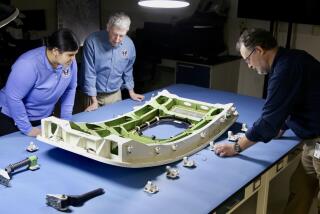FAA to Order Inspection of 747 Engine Mounts
In the wake of a weekend Dutch air disaster, the Federal Aviation Administration will order as many as 550 Boeing 747 jumbo jets to be inspected for possibly defective engine mounts, officials said Tuesday.
Details of the order, which may be issued as early as today, have yet to be worked out. But Dave Duff, an FAA spokesman in Seattle, said the order will call for inspections of the early-model 747-100, 747-200 and 747-300 passenger and cargo jets âwithin the next 10 hours, the next 10 days or the next 10 weeks.â
Duff said it is unlikely there will be a wholesale grounding of the 747 jumbo jets, which form the backbone of many international commercial fleets.
Longstanding concern over the engine mounts intensified Sunday when both starboard engines of the El Al 747-200F cargo plane fell from the jet minutes after takeoff from Amsterdamâs Schiphol Airport. The plane veered out of control and slammed into a high-rise apartment complex, killing as many as 250 people.
Last year, two starboard engines fell from a China Airlines 747-200 cargo jet seconds after takeoff from an airport near Taipei. The plane crashed into a hilltop, killing all five crew members.
Boeing Co. said reports over the years of corrosion and cracking in the four-inch âfuse pinsâ that fasten the engine struts to the wings on most early-model 747s had prompted the company to prepare a service bulletin Monday urging all airlines to inspect the pins for possible damage. The bulletins--which are advisory, not mandatory--were sent to 69 carriers.
Mondayâs bulletin, which followed Sundayâs crash and the relatively unpublicized Dec. 29 crash near Taipei, jogged the FAA into action; by midday Tuesday, officials in Washington were announcing that a mandatory inspection order would be issued this week.
Boeing stressed that the causes of the Taiwan and Netherlands crashes have yet to be determined and said pin failure has not been identified as causing any other 747 accidents.
âWe donât see any connection between China (Airlines) and El Al and the fuse pins,â said William N. Curry, a Boeing spokesman. âThere are some similarities (in the crashes), but there are some differences too.â
The engines that ripped from the China Airlines plane fell into the sea; the fuse pins from the engine mounts have not been found. The fuse pins from the El Al plane have not been found, either, but they are thought to have fallen over land or into a lake; officials think there is a good chance they will be recovered.
The lack of evidence leaves another question unanswered--whether the steel pins, each about 4 inches long and 2 1/2 inches across, may have given way to the stress under which they are supposed to fail.
Jack Gamble, a Boeing spokesman, explained that when a jet engine seizes up suddenly--as when it ingests a flock of birds--the enormous torque created by the sudden deceleration of the spinning turbo fan could tear away the wing.
The pins, two of which fasten each engine strut to the wing, are designed to give way under this type of torque; this lets the engine fall away cleanly and prevents the wing from failing. Aviation officials in Amsterdam have said that Schiphol Airport often has problems with flocks of birds that stray across the approach and departure routes.
Theoretically, a 747 missing two engines on one side can be flown successfully. But Gamble pointed out that there could have been other as yet unknown problems that may have contributed to both crashes.
Investigators are still searching through the apartment-house debris in Amsterdam in hopes of finding the El Al jets two flight recorders, both of which are designed to survive the impact and fire of a crash. The devices are expected to provide important evidence as to what caused the accident. One contains data on the planeâs flight path, the other a recording of cockpit conversations in the moments before the crash.
On Sept. 16, less than three weeks before the Netherlands crash, Boeing met with representatives of El Al and Swissair to discuss the fuse-pin problem and to outline plans for their redesign. âWe had received reports over the last seven years of 15 fuse pins that had shown signs of cracking, usually as a result of corrosion,â Gamble said.
Boeing said the affected pins had all been used on planes with Rolls-Royce and Pratt & Whitney engines. Planes with General Electric engines have not been affected.
Joe Hopkins, a United Airlines spokesman in Chicago, said his company began fuse-pin inspections as soon as Boeing issued its service bulletin; the checks are being made during regularly scheduled maintenance. He said the checks will not affect Unitedâs flight scheduling, and he said he doubted that other airlines would be seriously inconvenienced.
United has 10 747s covered by the service bulletin, Hopkins said. He said one plane has been inspected. Although superficial corrosion was found on one pin and there were a few scratches on another, both were in good enough condition to be put back on the plane.
He said that United inspections, which take about 10 hours per plane, should be completed within two weeks. Hopkins said the service bulletin calls for the inspections to be done within 90 days. But the FAA is not expected to allow that much time under its directive.
More to Read
Sign up for Essential California
The most important California stories and recommendations in your inbox every morning.
You may occasionally receive promotional content from the Los Angeles Times.










